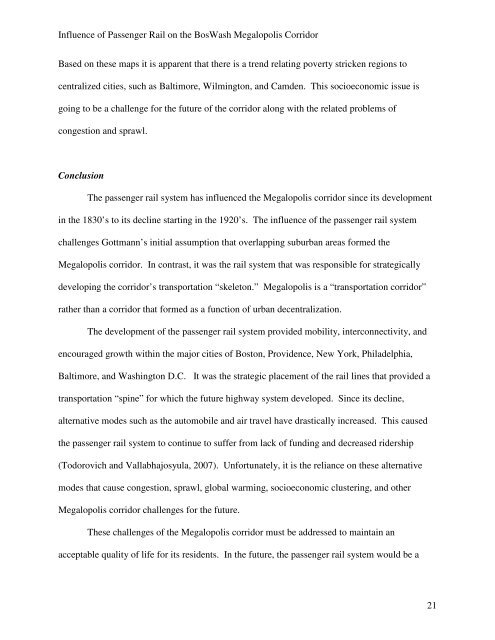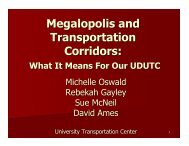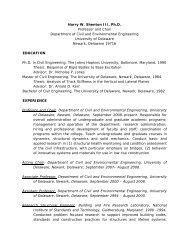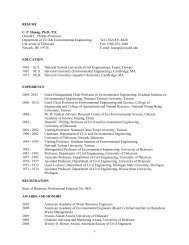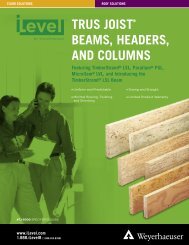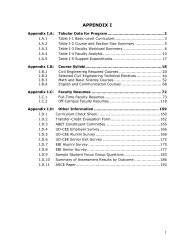Influence of Passenger Rail on the BosWash Megalopolis Corridor ...
Influence of Passenger Rail on the BosWash Megalopolis Corridor ...
Influence of Passenger Rail on the BosWash Megalopolis Corridor ...
Create successful ePaper yourself
Turn your PDF publications into a flip-book with our unique Google optimized e-Paper software.
<str<strong>on</strong>g>Influence</str<strong>on</strong>g> <str<strong>on</strong>g>of</str<strong>on</strong>g> <str<strong>on</strong>g>Passenger</str<strong>on</strong>g> <str<strong>on</strong>g>Rail</str<strong>on</strong>g> <strong>on</strong> <strong>the</strong> <strong>BosWash</strong> <strong>Megalopolis</strong> <strong>Corridor</strong><br />
Based <strong>on</strong> <strong>the</strong>se maps it is apparent that <strong>the</strong>re is a trend relating poverty stricken regi<strong>on</strong>s to<br />
centralized cities, such as Baltimore, Wilmingt<strong>on</strong>, and Camden. This socioec<strong>on</strong>omic issue is<br />
going to be a challenge for <strong>the</strong> future <str<strong>on</strong>g>of</str<strong>on</strong>g> <strong>the</strong> corridor al<strong>on</strong>g with <strong>the</strong> related problems <str<strong>on</strong>g>of</str<strong>on</strong>g><br />
c<strong>on</strong>gesti<strong>on</strong> and sprawl.<br />
C<strong>on</strong>clusi<strong>on</strong><br />
The passenger rail system has influenced <strong>the</strong> <strong>Megalopolis</strong> corridor since its development<br />
in <strong>the</strong> 1830’s to its decline starting in <strong>the</strong> 1920’s. The influence <str<strong>on</strong>g>of</str<strong>on</strong>g> <strong>the</strong> passenger rail system<br />
challenges Gottmann’s initial assumpti<strong>on</strong> that overlapping suburban areas formed <strong>the</strong><br />
<strong>Megalopolis</strong> corridor. In c<strong>on</strong>trast, it was <strong>the</strong> rail system that was resp<strong>on</strong>sible for strategically<br />
developing <strong>the</strong> corridor’s transportati<strong>on</strong> “skelet<strong>on</strong>.” <strong>Megalopolis</strong> is a “transportati<strong>on</strong> corridor”<br />
ra<strong>the</strong>r than a corridor that formed as a functi<strong>on</strong> <str<strong>on</strong>g>of</str<strong>on</strong>g> urban decentralizati<strong>on</strong>.<br />
The development <str<strong>on</strong>g>of</str<strong>on</strong>g> <strong>the</strong> passenger rail system provided mobility, interc<strong>on</strong>nectivity, and<br />
encouraged growth within <strong>the</strong> major cities <str<strong>on</strong>g>of</str<strong>on</strong>g> Bost<strong>on</strong>, Providence, New York, Philadelphia,<br />
Baltimore, and Washingt<strong>on</strong> D.C. It was <strong>the</strong> strategic placement <str<strong>on</strong>g>of</str<strong>on</strong>g> <strong>the</strong> rail lines that provided a<br />
transportati<strong>on</strong> “spine” for which <strong>the</strong> future highway system developed. Since its decline,<br />
alternative modes such as <strong>the</strong> automobile and air travel have drastically increased. This caused<br />
<strong>the</strong> passenger rail system to c<strong>on</strong>tinue to suffer from lack <str<strong>on</strong>g>of</str<strong>on</strong>g> funding and decreased ridership<br />
(Todorovich and Vallabhajosyula, 2007). Unfortunately, it is <strong>the</strong> reliance <strong>on</strong> <strong>the</strong>se alternative<br />
modes that cause c<strong>on</strong>gesti<strong>on</strong>, sprawl, global warming, socioec<strong>on</strong>omic clustering, and o<strong>the</strong>r<br />
<strong>Megalopolis</strong> corridor challenges for <strong>the</strong> future.<br />
These challenges <str<strong>on</strong>g>of</str<strong>on</strong>g> <strong>the</strong> <strong>Megalopolis</strong> corridor must be addressed to maintain an<br />
acceptable quality <str<strong>on</strong>g>of</str<strong>on</strong>g> life for its residents. In <strong>the</strong> future, <strong>the</strong> passenger rail system would be a<br />
21


